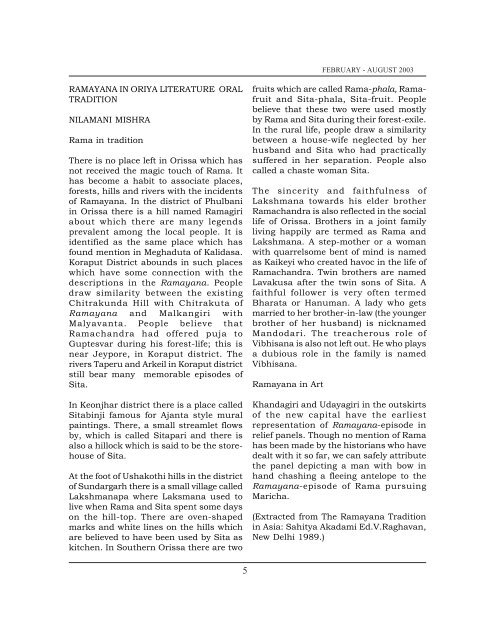Epics in Imprints-1.pdf - Vivekananda Kendra Prakashan
Epics in Imprints-1.pdf - Vivekananda Kendra Prakashan
Epics in Imprints-1.pdf - Vivekananda Kendra Prakashan
Create successful ePaper yourself
Turn your PDF publications into a flip-book with our unique Google optimized e-Paper software.
RAMAYANA IN ORIYA LITERATURE ORAL<br />
TRADITION<br />
NILAMANI MISHRA<br />
Rama <strong>in</strong> tradition<br />
There is no place left <strong>in</strong> Orissa which has<br />
not received the magic touch of Rama. It<br />
has become a habit to associate places,<br />
forests, hills and rivers with the <strong>in</strong>cidents<br />
of Ramayana. In the district of Phulbani<br />
<strong>in</strong> Orissa there is a hill named Ramagiri<br />
about which there are many legends<br />
prevalent among the local people. It is<br />
identified as the same place which has<br />
found mention <strong>in</strong> Meghaduta of Kalidasa.<br />
Koraput District abounds <strong>in</strong> such places<br />
which have some connection with the<br />
descriptions <strong>in</strong> the Ramayana. People<br />
draw similarity between the exist<strong>in</strong>g<br />
Chitrakunda Hill with Chitrakuta of<br />
Ramayana and Malkangiri with<br />
Malyavanta. People believe that<br />
Ramachandra had offered puja to<br />
Guptesvar dur<strong>in</strong>g his forest-life; this is<br />
near Jeypore, <strong>in</strong> Koraput district. The<br />
rivers Taperu and Arkeil <strong>in</strong> Koraput district<br />
still bear many memorable episodes of<br />
Sita.<br />
In Keonjhar district there is a place called<br />
Sitab<strong>in</strong>ji famous for Ajanta style mural<br />
pa<strong>in</strong>t<strong>in</strong>gs. There, a small streamlet flows<br />
by, which is called Sitapari and there is<br />
also a hillock which is said to be the storehouse<br />
of Sita.<br />
At the foot of Ushakothi hills <strong>in</strong> the district<br />
of Sundargarh there is a small village called<br />
Lakshmanapa where Laksmana used to<br />
live when Rama and Sita spent some days<br />
on the hill-top. There are oven-shaped<br />
marks and white l<strong>in</strong>es on the hills which<br />
are believed to have been used by Sita as<br />
kitchen. In Southern Orissa there are two<br />
5<br />
FEBRUARY - AUGUST 2003<br />
fruits which are called Rama-phala, Ramafruit<br />
and Sita-phala, Sita-fruit. People<br />
believe that these two were used mostly<br />
by Rama and Sita dur<strong>in</strong>g their forest-exile.<br />
In the rural life, people draw a similarity<br />
between a house-wife neglected by her<br />
husband and Sita who had practically<br />
suffered <strong>in</strong> her separation. People also<br />
called a chaste woman Sita.<br />
The s<strong>in</strong>cerity and faithfulness of<br />
Lakshmana towards his elder brother<br />
Ramachandra is also reflected <strong>in</strong> the social<br />
life of Orissa. Brothers <strong>in</strong> a jo<strong>in</strong>t family<br />
liv<strong>in</strong>g happily are termed as Rama and<br />
Lakshmana. A step-mother or a woman<br />
with quarrelsome bent of m<strong>in</strong>d is named<br />
as Kaikeyi who created havoc <strong>in</strong> the life of<br />
Ramachandra. Tw<strong>in</strong> brothers are named<br />
Lavakusa after the tw<strong>in</strong> sons of Sita. A<br />
faithful follower is very often termed<br />
Bharata or Hanuman. A lady who gets<br />
married to her brother-<strong>in</strong>-law (the younger<br />
brother of her husband) is nicknamed<br />
Mandodari. The treacherous role of<br />
Vibhisana is also not left out. He who plays<br />
a dubious role <strong>in</strong> the family is named<br />
Vibhisana.<br />
Ramayana <strong>in</strong> Art<br />
Khandagiri and Udayagiri <strong>in</strong> the outskirts<br />
of the new capital have the earliest<br />
representation of Ramayana-episode <strong>in</strong><br />
relief panels. Though no mention of Rama<br />
has been made by the historians who have<br />
dealt with it so far, we can safely attribute<br />
the panel depict<strong>in</strong>g a man with bow <strong>in</strong><br />
hand chash<strong>in</strong>g a flee<strong>in</strong>g antelope to the<br />
Ramayana-episode of Rama pursu<strong>in</strong>g<br />
Maricha.<br />
(Extracted from The Ramayana Tradition<br />
<strong>in</strong> Asia: Sahitya Akadami Ed.V.Raghavan,<br />
New Delhi 1989.)

















